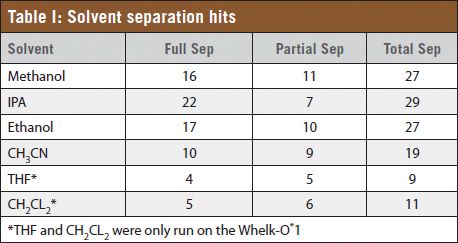Choosing an Optimal Co-Solvent for Method Development in Supercritical Fluid Chromatography (SFC) for the Whelk-O®1, RegisPack®, and RegisCell® Chiral Stationary Phases
Special Issues
The majority of the samples in this study and other studies show that a majority of compounds can be separated by the use of the three most common alcohols: IPA, CH3OH, and ethanol. Solubility becomes a crucial factor in preparative chromatography. Combinations of solvents can be used to improve solubility when the chosen co-solvent has poor solubility of the compound in question.
The criteria for choosing an optimal co-solvent is twofold. The first is to obtain the best suitable separation and resolution. Secondly, when scaling to a preparative separation, the ability of the co-solvent to solubilize the sample is of highest priority.
With all of the covalently bonded chiral stationary phases (CSPs) available in the market, the choice of solvents has increased. A study of various solvents will be tested on bonded and coated phases. Twelve randomly chosen samples will be run with a variety of solvents on the Whelk-O®1, RegisPack®, and RegisCell® phases.
Experimental Conditions
The instrumentation consisted of a Waters Thar analytical Method Station SFC System. The Whelk-O®1 is bonded with 1-(3,5-Dinitrobenzamido)-1,2,3,4,-tetrahydrophenanthrene. The RegisPack® polysaccharide-based CSP is coated with tris – (3, 5 – dimethylphenyl) carbamate of amylose. The RegisCell® polysaccharide-based CSP is coated with tris – (3, 5 – dimethylphenyl) carbamate of cellulose. All phases were based on 5 micron silica and packed into 25 cm × 4.6 mm ID columns.
Results
The solvents chosen for this study include methanol (CH3OH), 2-propanol (IPA), ethanol, acetonitrile (CH3CN), tetrahydrofuran (THF), and methylene chloride (CH2CL2).
Methyl tertiary butyl ether was taken out of the study as most of the compounds did not elute off the column. THF and CH2CL2 were only run on the Whelk-O®1 column as these two solvents would strip off the phase on the RegisPack® and RegisCell® CSPs.
Table I summarizes the number of hits for each possible solvent. There are a total of 36 hits possible for each of the solvents except THF and CH2CL2 where there are 12 possible for each solvent.

Table I: Solvent separation hits
With this particular set of solvents and samples, IPA appears to be the best co-solvent. The Whelk-O®1 had the greatest number of hits as shown in Table II.

Table II: CSP success rates (%)
Conclusions
The majority of the samples in this study and other studies show that a majority of compounds can be separated by the use of the three most common alcohols: IPA, CH3OH, and ethanol. Solubility becomes a crucial factor in preparative chromatography. Combinations of solvents can be used to improve solubility when the chosen co-solvent has poor solubility of the compound in question.

Regis Technologies, Inc.
8210 Austin Avenue, Morton Grove, IL 60053
tel. (847) 967-6000, fax (847) 967-5876
Website: www.registech.com

The 26th Norwegian Symposium on Chromatography
March 29th 2024The 26th Norwegian Symposium on Chromatography was held 21–23 January 2024. The symposium has strong traditions in the Norwegian separation science community, serving as a forum for excellent scientific talks, networking, and social events.

.png&w=3840&q=75)

.png&w=3840&q=75)



.png&w=3840&q=75)



.png&w=3840&q=75)












